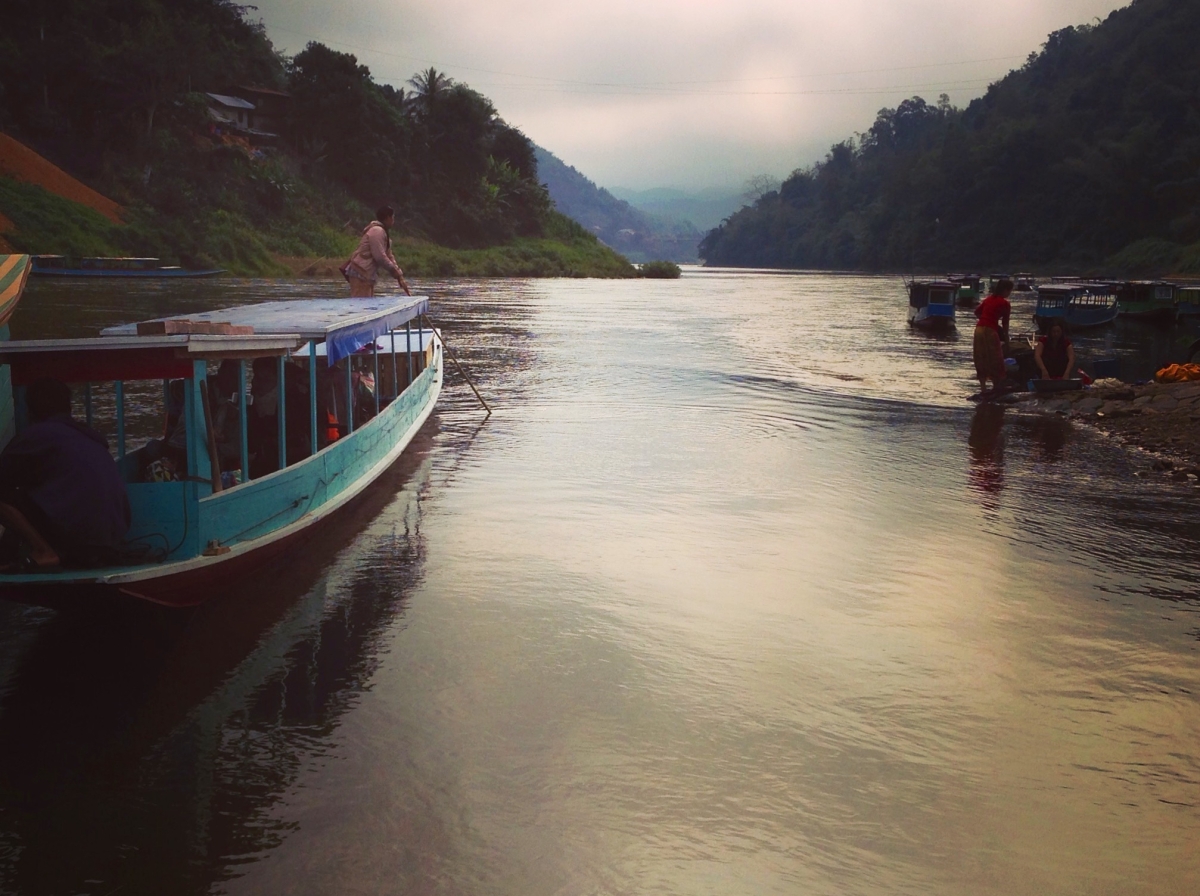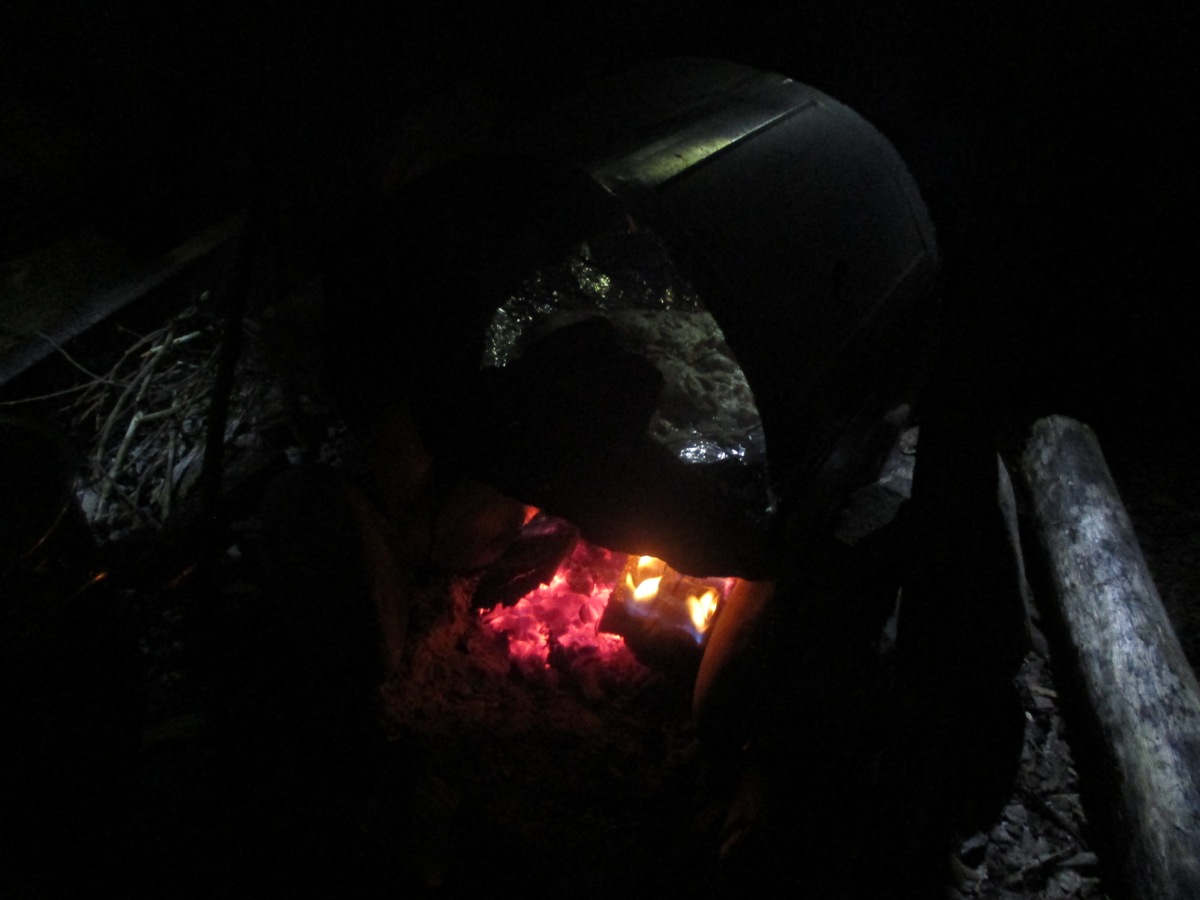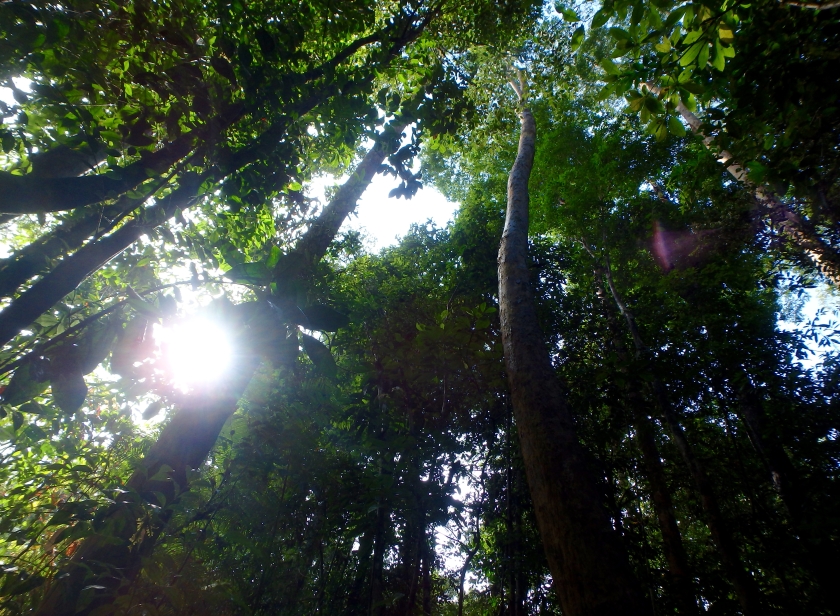Landlocked Laos may not lie adjacent to any ocean but it more than compensates with a twisting network of rivers that crisscross the country like veins. In the rainy season, the rivers rage with wild rapids. However, visit in the drier season (I was there in March) and you’ll be rewarded with one of the jewels in the crown of Northern Laos: a slow boat trip down the Nam Ou.
From travellers I had met in Vietnam, reports of Laos did not tend to be glowing. ‘Just go for a couple of weeks,’ we were advised, with warnings that it was a bit boring. After 24 hours, we utterly disagreed. I cannot deny that Laos is hands down the most laid back place I have ever visited. Everything happens in slow motion; its languid rivers flow lazily through shallow valleys; even the dogs are more chilled out as they lounge in the shade. But I think that this is a huge part of its charm. Relax into its dreamy vibes and you’ll find yourself spending longer there than you planned.
After an exhausting journey from Vietnam, we spent the night in a guesthouse in Muang Khua which clung precariously to the sides of the riverbank, accessible only over a rickety bridge which was only sketchily nailed together. Our landlady didn’t speak a word of English but shyly smiled and showed us to our rooms. The walls were made from woven bamboo and for the first time felt homely; mosquito nets foamed down from the ceiling onto piles of blankets and from the window we could see the gentle flow of the Nam Ou. For less than £2 for a night, it was not a sore deal. Dinner was slow in coming – we would learn that everything in Laos happens in Laos time – but delicious. It was our first experience of Laos sticky rice, which generally is cooked at breakfast time and eaten with every meal.
Sticky rice is made from a specific opaque rice grain called glutinous rice and has been cultivated throughout South East Asia for over a thousand years. About 85% of all rice in Laos is of this type. It is steamed and comes in little wicker baskets with a top attached with string. Eat it with your hands, rolling it into walnut-sized balls, and dip it into whatever you choose to eat it with. Eat it all the time for every meal. It. Is. Incredible. Stay tuned on the blog for my Ode to Sticky Rice. There is an age-old debate as to whether sticky rice is traditionally Thai or Lao. Having travelled round both, I would argue that it is hands-down Lao. Sticky rice for life.
After a comfortable nights sleep, we were up bright and early for the slow boat at 8 which came at 9.30. Papaya and mango with Lao coffee for breakfast before heading down to the stone ramp that went down to the river. We handed our backpacks down onto the boat, a long wooden riverboat painted blue with a wooden covering held down by bricks. We climbed aboard. Bags went down one end; people on the other. I folded my waterproof over to make a cushion to sit on and folded up my knees slightly to fit into the width of the boat. When everybody was on, ropes were untied and the woman driving the boat pushed off from the river bank with an oar so that we were slowly free-floating down the river.

The scenery was beautiful as we drifted downstream. Striking karst hills carpeted in a cloak of emerald greenery flanked the Nam Ou as it wound through flat-bottomed valleys. The sky was a pale forget-me-not blue edged with wispy clouds that clung to the limestone peaks climbing upwards into jagged triangulations. The sun shone serenely through a lazy haze, warm and balmy, while a gentle breeze cooled the skin. There was an occasional spray of water as our vessel surged through rougher parts of the river.
We occasionally stopped the boat to pick people up who were waiting by the sides of the river to get a lift downstream. Sometimes they drew up alongside the boat in smaller thinner canoes, jumping nimbly across to us. After a couple of hours, a few of us desperately needed the toilet so we pulled up alongside a sand bank and disappeared into the trees, the sand burning our feet in the sun. I squatted in a bush next to some pigs who looked faintly appalled and wandered away to snuffle elsewhere. We stopped off at a riverside village called Muang Ngoi Neua, a charming place where I would recommend staying if you have the time. Although we didn’t stay here, we heard really good things about it. We grabbed lunch here and said goodbye to the people we’d met on the crossing from ‘Nam and who we’d chilled with for the last few hours on our gentle journey downstream.
It wasn’t long until we arrived in Nong Kiaw, a slightly larger town than Muang Ngoi Neua, but still a village really as it takes less than 10 minutes to walk through the whole thing. It is surrounded by the same limestone scenery that we saw from the river which we planned to explore some more the next day. Meanwhile the sun was starting to set on the river, its pinkish hue contrasting with the deep greens of the forest reflected in the slowly moving water. We ate dinner alongside the river to the last shafts of rosy sunlight which faded to a darkness punctuated by the flickering flames of the lamps on our table. We tried ‘laap’, a Lao speciality of minced meat fried with chilli, herbs, lime juice and toasted rice, accompanied by sticky rice.

The next day was spent exploring and getting lost in the surrounding countryside, amongst the karst mountains and caves, not straying far from the road due to unexploded ordinance left in the area from the America/Vietnam War. On the way back to Nong Kiaw, we paid a visit to the Tham Pha Tok caves, which is where villagers hid out during the Second Indochina War as American bombs rained on Laos. For a time, the Luang Prabang government was also based in this cave system. Originally accessible by a rickety bamboo ladder, a new wooden staircase now rises to the cave’s entrance. Take a flashlight as you navigate the chambers of the cavern – there are a few signs about but not an awful lot of information on display. However, it is still interesting being in the caves and imagining what happened here not so long ago.
We walked back a couple of kilometres to town where we had a late lunch of Indian dosa with a Dutch girl we’d made the crossing to Vietnam with, who happened to be walking past. Stomachs full, we decided to walk up Phadeng Peak to the town’s viewpoint. In hindsight, doing it on a full stomach wasn’t the best idea. Although no Fansipan, the trek went steeply uphill in the afternoon heat. I had brought a camera rather than a bottle of water – priorities – so was dehydrated in the almost oppressive heat. We were all dripping with sweat by the time we reached the top but the 360° vista which awaited us at the summit was worth the walk. A pinkish sun wreathed in pale clouds was sinking slowly into the embrace of the jagged limestone hills, the light sparkling and enchanting the long loops of the river. We sat by a rice sack ‘flag’ blowing in the wind as the sun set, deciding to make our way down as the light became cloaked in cloud. It got darker as we made our way down and needed a flashlight to navigate the winding path before we reached the bottom.

After showering off all our sweat, we went out to go eat more Lao food. I ordered Lao sausage, spiced win lemongrass and chill, which came with sticky rice (of course), greens, fried river weed with sesame seeds and a spicy aubergine dip (‘jeow’). It was washed down with a Beerlao, the national rice beer which comes in huge bottles and is actually really good. We went back to the hostel and cuddled with their kittens before heading to bed. We were reluctantly leaving the riverlands, travelling West to Nam Tha National Park, the next day. We had actually looked to see whether we could travel there by river for it is possibly the most relaxed form of transport in the world. However, being the dry season, there was no chance and so it was that we changed from boat back to bus for the next leg.














 The other not-so-perfect part of our experience occurred towards the end of the day, when Roza realised she had lost her purse. We had had to change boats halfway through the day and she had assumed she’d left it on the first boat. However, the guy on our boat had radioed back to the first vessel: they had her purse, it was all fine. But then he started to demand money from us alleging that we had not paid for a number of the day’s activities. We had, and gave him the number of our hostel so they could confirm this. He paid no attention and started to blackmail us, stating that he would not give back the purse if we did not pay him. We got back to land, where it transpired the purse was left on the bus we’d caught to the harbour. Two things we learnt from this: firstly to keep valuables on us at all times and secondly that some people won’t hesitate to lie through their teeth if they have something to gain from you. Of course, these people are not in the majority – a number of people helped get the purse back – but it is sadly something to be aware of when travelling. I do not wish to end on this note. Halong Bay is an area of outstanding natural beauty with its emerald topped peaks amidst an cerulean ocean topped with a snaking mist. And we didn’t even see it on a sunny day. I’ll leave you with a story.
The other not-so-perfect part of our experience occurred towards the end of the day, when Roza realised she had lost her purse. We had had to change boats halfway through the day and she had assumed she’d left it on the first boat. However, the guy on our boat had radioed back to the first vessel: they had her purse, it was all fine. But then he started to demand money from us alleging that we had not paid for a number of the day’s activities. We had, and gave him the number of our hostel so they could confirm this. He paid no attention and started to blackmail us, stating that he would not give back the purse if we did not pay him. We got back to land, where it transpired the purse was left on the bus we’d caught to the harbour. Two things we learnt from this: firstly to keep valuables on us at all times and secondly that some people won’t hesitate to lie through their teeth if they have something to gain from you. Of course, these people are not in the majority – a number of people helped get the purse back – but it is sadly something to be aware of when travelling. I do not wish to end on this note. Halong Bay is an area of outstanding natural beauty with its emerald topped peaks amidst an cerulean ocean topped with a snaking mist. And we didn’t even see it on a sunny day. I’ll leave you with a story.














 Foaming white in the midday sun against a curtain of leaves of a thousand shades of green: emerald, jade, venom. Above the falls is a viewing platform built by previous generations of Raleigh groups: for a few minutes all we could do is stand and stare at our surroundings, trying in vain to take everything in. Even now, as the phase is well underway, every member of the group has moments when they stop and are struck by the beautiful reality of where we are. It is something that is truly quite special and we are privileged to be here.
Foaming white in the midday sun against a curtain of leaves of a thousand shades of green: emerald, jade, venom. Above the falls is a viewing platform built by previous generations of Raleigh groups: for a few minutes all we could do is stand and stare at our surroundings, trying in vain to take everything in. Even now, as the phase is well underway, every member of the group has moments when they stop and are struck by the beautiful reality of where we are. It is something that is truly quite special and we are privileged to be here.












